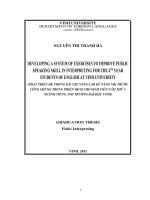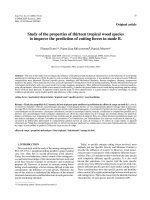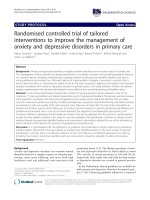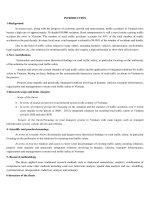Measures to improve the human resource in Kiên Giang
Bạn đang xem bản rút gọn của tài liệu. Xem và tải ngay bản đầy đủ của tài liệu tại đây (4 MB, 6 trang )
Development
of
The human resource plays a key role
in the economic development because a
high-quality human resource allows an
effective exploitation of other resources,
and helps create or get access to new
technologies and modern managerial
methods needed for improvements in
labor productivity and income. Realities
show that, however, the human resource
in Kieân Giang is of poor quality and
structure. This paper tries to examine
causes of the situation and offer measures to improve the human resource for
a sustainable development of Kieân Giang
economy in an effort to reduce dependence on natural resource and avoid potential difficulties in future.
Keywords: human resource, economic development, natural resources, technology, income.
1. Introduction
at present, all countries try their best to make
the best use of external resources and at the same
time, pay full attention to internal ones. of components of internal strength of a country, the
human resource is considered as a decisive one.
experience from developed countries proves the
key role played by the human resource (Barro,
2001; Hanushek and Kimko, 2004; and Ding and
Knight, 2011; etc.). paying full attention to the development of human resource becomes a condition
for economic growth, especially creative thinking,
sense of responsibility and professional competence. realities in Kieân Giang show that its
2
Economic Development Review - June 2011
human resource
human resource is of poor quality (laborers with
university degrees represent only a small proportion) and poor structure (most laborers work in
farming and fishery sector), and therefore it fails
to act as a dynamic of the economic growth.
the paper, therefore, aims at working out
measures to enhance the quality of human resource in Kieân Giang by training local laborers,
attracting ones from other provinces and employing them effectively. to achieve the aim, we use
factor analysis and descriptive statistics to process
primary data collected randomly from laborers
and managers in Kieân Giang and secondary data
from relevant authorities.
2. An overview of Kieân Giang human resource
Kieân Giang population in 2009 was 1,688,228
persons and its average growth rate in 1999-2009
was 1.2%. With a coastal line of 200 km long, fertile soil, abundant source of minerals, and beautiful landscape, Kieân Giang has good potentials for
economic development, especially the marine
economy.
favorable natural conditions allows a high personal income in Kieân Giang (us$1,167 in 2009
compared with the national average of us$1,064).
In 2009 the share of agriculture in gross output of
the province was 44.2% compared with 24% of the
manufacturing sector and 31.8% of the service sector. the structure of industry has changed favorably in recent years but the change was slow and
uneven among industries. fast development was
found only in sea farming and aquatic product processing while hi-tech industries are totally absent.
potentials for development are tapped ineffec-
* Caàn Thô University
** Kieân Giang College of Economics and Technology
Development
of
tively, which leads to wastes of land; and mineral,
marine and tourism resources. the economic
growth rate is pretty high but not sustainable because it depends too much on natural resources.
the fishery –provincial key industry- is facing
great challenges because of rapid exhaustion of
marine resources caused by unruly exploitation.
these shortcomings come directly from poor
quality of the human resource. as an agricultural
province, the working population of Kieân Giang
have a poor education and vocational training, and
lack a creative thinking. Industrialization and
modernization requires a well-trained workforce
while the education system of the province is weak
and local authorities have no measures to attract
well-trained laborers from other provinces with
the result that trained laborers accounted for only
25.9% of the provincial labor force in 2009. In addition, habit of relying on natural resources is
common among authorities, businesspersons and
peasants as well, and as a result, priority is never
given to plans to enhance the quality of human resources.
human resource
ing courses only) is on the increase. In 2007, there
was only 0.04 laborer with postgraduate degree
out of 1,000 laborers in comparison with 37.16 laborers with university first degrees; 29.12 laborers
with technical secondary education and 135.17 laborers experiencing only short-term training
courses. these figures in 2009 were 0.43; 37.76;
32.57 and 188.24 respectively, which show that
the human resource is of poor quality and slowly
improved (taân, 2001).
If no measures are taken to improve the situation, Kieân Giang economy will be in the doldrums
because it depends totally on exploitation of natural resources by manual labor, which will not only
fail to create a basis for a sustainable development
but also lead to a “poverty trap” when natural resources are used up as pointed out by studies on
natural resource curse (sachs and Warner, 2001;
andersen and aslaken, 2008; and Williams, 2011;
etc).
3. Human resource development in Kieân Giang
Generally, the education and training system
in Kieân Giang has failed to meet the market de-
Table 1: Trained labor in Kieân Giang (2007-2009)
Education
Postgraduate degree
University first degree
Technical high school
2007
Laborer
2008
As %
Laborer
2009
As %
Laborer
As %
342
0.2
346
0.2
379
0.2
31,757
18.4
32,368
16.4
33,063
14.6
24,889
14.4
26,607
13.4
28,515
12.6
Short-term training course
115,526
67.0
137,926
70.0
164,818
73.6
Total
172,514
100.0
197,247
100.0
226,775
100.0
Source: Report on Program of human resource development by Kieân Giang People’s Committee.
In fact, changes in quality of human resource
in Kieân Giang in recent years have not been remarkable, especially in the army of laborers with
university first degree and higher. table 1 shows
that the army of laborers with postgraduate degrees in Kieân Giang in 2009 rose to 379 from 346
in 2008 (an increase of 9.5%) and 342 in 2007 (an
increase of 10.8%). number of laborers with university first degree in 2009 increased to 33,063
from 32,368 in 2008 (2.1% up) and 31,757 in 2007
(4.1% up). It is worth noting that proportion of laborers with secondary and higher education to the
labor force is on the decrease while the proportion
of poorly-trained laborers (with short-term train-
mand. the following table 2 shows that in spite
of increases in the number of schools, the proportions of pupils and of graduates from high schools
to 10,000 persons were on the decrease. this situation must be dealt with properly because high
school graduates constitute a source of welltrained labor in future.
Economic Development Review - June 2011
3
Development
of
Table 2: School and pupil in Kieân Giang (2007-2009)
Indicator
General school
2007
2008
2009
492
506
513
Ratio of pupil to 10,000
residents
1,772
1,766
1,723
Proportion of high
school graduates (%)
73.92
75.99
59.38
Source: Kieân Giang Statistics Office; Nieân giaùm thoáng keâ
2009 (2009 Statistical yearbook).
table 3 shows that number of students and
graduates of technical high schools and vocational
centers rose steadily in 2007 – 2009; and ratio of
graduates to new students was rather high while
the ratio of university graduates to freshmen was
low, and very much lower in comparison with the
population of the province although courses given
at Kieân Giang training centers in cooperation
with prestige universities were not as excellent as
expected.
human resource
governmental agencies in Kieân Giang. factor
analysis method helps identify the following components of shortcomings of the labor force:
f1 = 0,199GIaIQuYetvanDe + 0,170nHaYBen + 0,167lamvIecDoclap +
0,207cHuYennGHIep + 0,264apluc +
0,282GanBo + 0,131tracHnHIem
f2 = 0,355tHIcHnGHI + 0,298GIaotIep +
0,294cHuYenmon + 0,442Hocluc
f3 = 0,542cautIen + 0,567HocHoI
according to managers, love of learning (HocHoI), love of progress (cautIen), and ability
to learn (Hocluc) are main shortcomings of surveyed laborers, along with ability to adjust to work
(tHIcH nGHI), people skill (GIao tIep), expertise (cHuYenmon), sense of attachment
(GanBo) and ability to deal with pressure
(apluc); while sense of responsibility (tracHnHIem), and ability to work independently
(lamvIecDoclap), etc. are considered as unimportant. lack of love of learning, love of progress,
ability to deal with pressure and sense of attachment among laborers will affect badly the produc-
Table 3: Student in Kieân Giang (2007 – 2009)
2007
Level
Newly
admitted
2008
Graduate
Newly
admitted
2009
Graduate
Newly
admitted
Graduate
University*
1,316
276
1,841
542
2,300
935
Three-year college
1,404
642
1,574
716
2,256
782
Technical high school
1,999
1,422
3,431
2,291
2,514
2,545
19,769
20,036
22,400
22,135
26,892
26,447
Vocational training
Source: Report on Program of Kieân Giang human resource development.
Note: (*) in cooperation with universities from other provinces.
the army of university graduates in Kieân
Giang is poor in terms of both quality and quantity. to evaluate it more exactly, we have interviewed randomly 137 graduates who are working
in Kieân Giang. none of them graduated with honors, three of them ranked excellent (2.2%), 63 good
(46%) and 71 medium (51.8%). these data show
that Kieân Giang is badly in need of competent laborers.
the analyses allow a conclusion that the
provincial labor force is poor and full of shortcomings. to identify them, we have interviewed randomly 91 managers of companies and
4
Economic Development Review - June 2011
tivity in Kieân Giang in a long term because poor
and changing performance of labor force makes it
difficult for authorities to carry out long-term
training programs.
In addition, the army of managers in Kieân
Giang also reveals shortcomings. a random survey
of 89 managers (44 executives in governmental
agencies and 45 managers in companies) shows
that of 44 executives as civil servants, only three
of them (6.8%) had postgraduate degrees; 38 university first degrees (86.4%); two three-year college degrees (4.5%) and one high school degree
(2.3%). as for corporate managers, one of them
Development
of
(2.2%) had postgraduate degrees; 33 university
first degrees (73.3%); three three-year college degrees (8.9%); four high school degrees (8.9%); and
four had no formal training (8.9%).
the data prove that human resource development in Kieân Giang has not been carried effectively regardless of various policies and plans
adopted by the provincial government, such as
plan 23/KH-uBnD approved on may 9, 2006 to
train postgraduate labor in foreign universities in
2006-2015; resolution 44/2007/nQ-HÑnD dated
July 1, 2007 on the program of human resource development up to 2020; plan 42/KH-uBnD dated
July 19, 2007 on development of education and
training service up to 2010 and directions for
2010-2015 period; Decision 1381/QÑ-uBnD made
on aug. 2, 2007 by Kieân Giang people’s committee on the plan to train vocational teachers up to
2010; Decision 34/2007/QÑ-uBnD dated aug. 17,
2007 on the program of human resource development up to 2020; plan 50/KH-uBnD dated July
21, 2008 to train 50 masters/doctors and 200
young experts to hold high positions in future in
2008-2015; Decision 621/QÑ–uBnD dated march
17, 2008 on the list of occupations and professions
of top priority for Kieân Giang socioeconomic development; and Decision 1726/QÑ-uBnD dated
July 16, 2009 to form a management board for the
plan 23/KH-uBnD to help experts to do postgraduate studies in foreign universities, etc.
these shortcomings come from some incorrect
view on importance of human resource development among provincial leaders with the result
that effort and outlay on education and training
are limited and misused. In the coming years, the
provincial authorities should work out and implement properly policies on human resource development and preferential treatment towards
well-trained labor to make the best use of existing
potentials.
4. Effort to attract well-trained labor
attracting well-trained labor from other
provinces and cities is also a good measure to improve the labor force quality. this effort depends
totally on vision taken by leaders of the province.
If they recognize the importance of human resource, their behavior towards the talents will attract them to Kieân Giang. In recent years, many
policies have been adopted by the provincial gov-
human resource
ernment to attract well-trained labor. the following are some of them.
- Decision 12/2007/QÑ-uBnD dated feb. 6,
2007 on allowances of vnD20 million for professors, 15 million for associate professors, 20 million
for doctors, 10 million for masters, 3 million for
graduates of excellent rank, 2 million for graduates of good rank and 1 million for graduates of
medium rank.
- Decision 12/2009/QÑ-uBnD dated feb. 18,
2009 on incentives for experts from other
provinces: (a) an initial allowance of vnD20 million for masters, specialized physicians of second
level; (b) an initial allowance of vnD30 million for
professors and doctors who teach in subjects and
courses that universities and colleges in Kieân
Giang cannot give.
such policies, however, are not attractive
enough because they only offer some financial support without paying attention to other factors affecting laborers’ decision. In addition, these
policies reflect a favor-giving manner instead of a
wish to develop a high-quality labor force for local
economic growth. competent laborers tend to protect their freedom and think carefully before making decision on offers they receive by asking
questions about job descriptions, working environment, promotion prospects, living conditions, and
corporate culture, and so on. apparently, Kieân
Giang policies on external sources of labor cannot
answer satisfactorily these questions. that is why
few people ventured to take offers from Kieân
Giang because they did not know how they could
manage when initial allowance was used up and
other opportunities were gone. the situation is
presented in table 4.
Table 4: Sources of labor in Kieân Giang
(2007 – 2009)
By expertise
Source
Inside Kieân
Giang
Outside
Total
High
school
College
UniMaster Doctor
versity
206
122
194
3
6
12
23
55
0
0
218
145
249
3
6
Source: Survey of 91 organizations in Kieân Giang.
Economic Development Review - June 2011
5
Development
of
table 4 shows that 91 surveyed organizations
have recruited 218 high-school graduates (206 from
Kieân Giang and 12 from external sources); 145 college graduates (122 and 23 respectively); 249 university graduates (194/55); and three masters and
six doctors from local sources. It is worth noting
that they could not recruit masters or doctors from
external sources. this problem can only be solved
by understanding factors affecting laborers’ decision on their workplace. to clarify the problem, we
surveyed randomly 144 laborers with university
first degree. By applying factor analysis importance
of factors affecting their decision is as follows:
f1 = 0,163tHunHapcao + 0,335cvonDInH
+ 0,335DunGnGHe + 0,289nanGcaotrInHDo
+ 0,344moItruonGtot
f2 = 0,284DeXInvIec + 0,275DanHtIenG +
0,447GanGIaDInH + 0,471tHanGtIen
results show that tHanGtIen (promotion
prospects) produces the biggest effect on laborers’
decision, followed by GanGIaDInH (being near to
home), and moItruonGtot (good working environment), etc. the weakest effects are from DeXInvIec (being easy to get job), DanHtIenG
(corporate prestige) and tHunHapcao (starting
high salary).
thus, the job offer is much more attractive to
well-trained laborers if it provides a good working
environment, promotion prospects and convenient
location. provincial authorities should pay more attention to these aspects.
5. Measures
the above analyses show that the breakthrough
in effort to enhance the labor force quality is to
adopt a right conception of the key role of human
resource in economic growth. In addition, the habit
of relying on natural resources must be broken. one
of measures to achieve this aim is to impose heavy
severance taxes with a view to forming a habit of
protecting and using rationally natural resources.
severance tax payment could be used for developing
the education and training system and technologyintensive industries to secure a sustainable development in future. moreover, provincial authorities
must pay more attention to tasks of training, attracting and employing the labor force.
6
Economic Development Review - June 2011
human resource
a. Training:
- Increasing investment in facilities for training
and expanding the network of schools should be included in an overall plan to beef up and enhance
quality of general education service. In addition,
the provincial government should consider establishing a Kieân Giang university; and expanding
and upgrading the community college, college of
Health care, and college of economics and technology.
- allowing participation of private sector in education service: one of difficulties facing the education authority is the shortage of fund. that is
why the participation of other sectors in education
service becomes so necessary. to secure a good and
effective participation, Kieân Giang authorities
should adopt new policies to support non-public
schools and encourage participation of private persons in establishment of schools according to the
master plan worked out by the state.
- enhancing quality of the army of teachers:
there must be policies to encourage teachers to enhance their performance by offering preferential
treatment and incentives because it is the army of
teachers that undertake the task of providing potential laborers with knowledge and work ethic.
b. Attracting laborers from other provinces:
as analyzed above, the decisive factor in the effort to attract well-trained labor is the vision
adopted by the leadership. the provincial government, therefore, should notice such solutions as:
- creating an open and favorable working environment: Important aspects of this task are (1)
good working conditions; (2) business autonomy
provided that it is compliant with principles; and
(3) an increasingly improved living standard.
- assigning important tasks to the talents, respecting personal competence, developing young
generations, and struggling against the cronyism
when employing laborers and deciding on promotion.
- looking for excellent students from Kieân
Giang: as for excellent students, scholarship could
be offered to help them continue their postgraduate
studies at home or abroad. Besides financial support, other forms of help, such as a dormitory for
Development
of
students from Kiên Giang and bus tickets to home
towns at summer vacation and tết festival, are
also desirable.
c. Employing the labor force:
training and attracting well-trained labor are
very difficult but they can quit Kiên Giang for better-paid jobs if their skills are not employed properly. full attention must be paid to the following
aspects when employing the well-trained labor:
- establishing a mechanism for receiving and
assigning tasks to employees according to their
skills and expertise, and only promoting persons
whose competence is equal to the task.
- Downsizing could be considered as a measure
to recruit competent laborers, along with selecting
candidates for high positions by holding competitive examinations or elections.
- evaluating work performance regularly in
order to discover shortcomings, thereby taking action to deal with them (replacing the laborers in
question, or sending them to refresher courses,
etc.).
- assessing the laborers through their performance instead of working hours to encourage them
to tap their potentials to the full.
6. Conclusion
the only way to a sustainable development is to
enhance the quality of human resource. like other
provinces in the mekong Delta, Kiên Giang is rich
in natural resources, which allows a high personal
income but also leads to heavy dependence on natural conditions for economic growth. the provincial
government has tried its best to find measures to
deal with the situation in recent years.
policies adopted by Kiên Giang authorities,
however, are not really effective with the result
that the proportion of high-school graduates fell,
the army of well-trained laborers could not increase, and structure of labor is not as reasonable
as expected because of lack of efforts from both
local authorities and the public. moreover, university graduates from Kiên Giang are reluctant to return to their home province for jobs because the
Kiên Giang economy depends too much on seafarming, seafood processing and cement industries
human resource
while policies on labor from external sources ended
in failure because they could not meet demand of
skilled laborers.
to enhance the Kiên Giang labor force quality,
the paper offer the following measures: (1) Breaking the habit of relying on natural resources; (2)
Disseminating a right view on importance of the
human resource among leaders of the province; (3)
making more investments in development of the
network of schools and army of teachers; (4) creating an open and fair environment for laborers;
(5) selecting candidates for high position through
examination or election; (6) making necessary adjustments based on regular evaluation of labor force
quality; and (7) assessing laborers through their
performance instead of working hours. these measures, when carried out effectively, can enhance the
quality of human resource, thereby ensuring a sustainable development for Kiên Giang economyn
Reference
1.
Andersen, J. & S. Aslaken (2008), “Constitutions
and the Resource Curse,” Journal of Development Economics 87, pp. 227–246.
2.
Barro, R. (2001), “Human Capital and Growth,”
American Economic Association Papers and Proceedings
91(2), pp. 12–17.
3.
Ding, S. & J. Knight (2011), “Why Has China
Grown So Fast? The Role of Physical and Human Capital
Formation,” Oxford Bulletin of Economics and Statistics
73(2), pp. 141–174.
4.
Hanushek, E. & D. Kimko (2004), “Schooling,
Labor-Force Quality, and the Growth of Nations,” American
Economic Review 90(5), pp. 1184–1208.
5.
Sachs, J.D. & A.M. Warner (2001), “The Curse
of Natural Resources,” European Economic Review 45, pp.
827–838.
6.
Tân, T.M. (2011), “Giải pháp nâng cao chất lượng
nguồn nhân lực cho phát triển kinh tế ở Kiên Giang”, (Measures to enhance the quality of human resource of Kiên
Giang), unpublished Master thesis, Cần Thơ University.
7.
Williams, A. (2011), “Shining a Light on the Re-
source Curse: An Empirical Analysis of the Relationship
between Natural Resources, Transparency, and Economic Growth,” World Development 39(4), pp. 490–505.
Economic Development Review - June 2011
7









